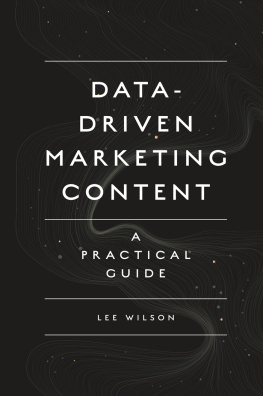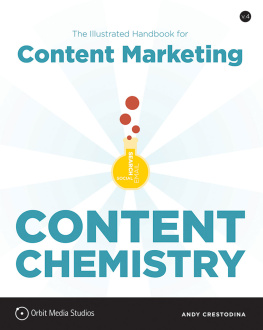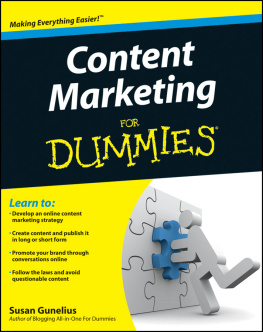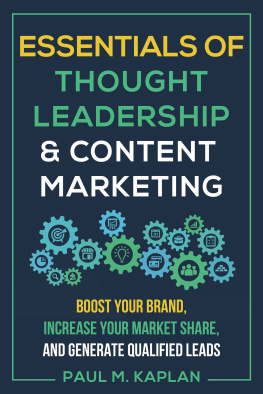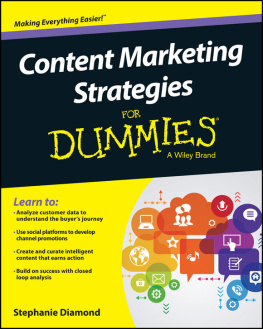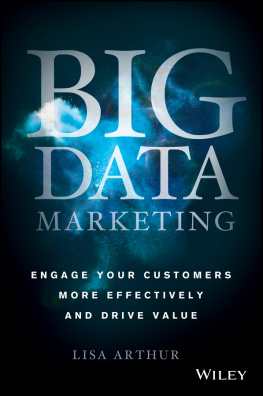Lee Wilson - Data-Driven Marketing Content: A Practical Guide
Here you can read online Lee Wilson - Data-Driven Marketing Content: A Practical Guide full text of the book (entire story) in english for free. Download pdf and epub, get meaning, cover and reviews about this ebook. year: 2019, publisher: Emerald Group Publishing, genre: Business. Description of the work, (preface) as well as reviews are available. Best literature library LitArk.com created for fans of good reading and offers a wide selection of genres:
Romance novel
Science fiction
Adventure
Detective
Science
History
Home and family
Prose
Art
Politics
Computer
Non-fiction
Religion
Business
Children
Humor
Choose a favorite category and find really read worthwhile books. Enjoy immersion in the world of imagination, feel the emotions of the characters or learn something new for yourself, make an fascinating discovery.
- Book:Data-Driven Marketing Content: A Practical Guide
- Author:
- Publisher:Emerald Group Publishing
- Genre:
- Year:2019
- Rating:3 / 5
- Favourites:Add to favourites
- Your mark:
- 60
- 1
- 2
- 3
- 4
- 5
Data-Driven Marketing Content: A Practical Guide: summary, description and annotation
We offer to read an annotation, description, summary or preface (depends on what the author of the book "Data-Driven Marketing Content: A Practical Guide" wrote himself). If you haven't found the necessary information about the book — write in the comments, we will try to find it.
Lee Wilson: author's other books
Who wrote Data-Driven Marketing Content: A Practical Guide? Find out the surname, the name of the author of the book and a list of all author's works by series.
Data-Driven Marketing Content: A Practical Guide — read online for free the complete book (whole text) full work
Below is the text of the book, divided by pages. System saving the place of the last page read, allows you to conveniently read the book "Data-Driven Marketing Content: A Practical Guide" online for free, without having to search again every time where you left off. Put a bookmark, and you can go to the page where you finished reading at any time.
Font size:
Interval:
Bookmark:

There is more information being collected today than at any other stage during human existence. As you might expect, a substantial amount of this data can be used for enhancing your existing marketing content, plus creating new marketing material that works harder, plus contributing more towards your professional and business goals.
This wealth of new data poses a substantial threat and untapped opportunity for individuals, practitioners and businesses alike, when it comes ideating and producing effective business and marketing content, as well as keeping in touch of the growing online and offline competition.
To put new data growth into context, every minute Google completes 3.6 million searches, 103 billion spam emails are sent and 69 thousand hours of video is streamed on Netflix, and thats just the beginning.
Based on IBM data, 90% of all data available to us today were created in the past two years; this equates to 2.5 quintillion bytes of data created every day, demonstrating the rapid changes in data availability, and the business opportunity to leverage this wealth of ever-increasing data for new insights, actions and a competitive company advantage.
Data-driven Marketing Content: A Practical Guide empowers you to identify, understand and act on ever-changing data to make meaning from the deep data dilemma.
Everyone can have access to data-driven insights, which can turn mundane, thinner value content into purposeful, positioned marketing materials created with the user in mind, and is able to deliver results regardless of medium, marketing channel or intended audience.
Businesses and practitioners in all industries are at a point where they know there is a need to understand and use data more effectively to create result-based content, but the informational barriers to entry are often high.
For companies to succeed, they need to act fast and confident that the practical and strategic marketing content decisions they make, combined with the resource they deploy, are going to deliver end results faster and more frequently.
This is where Data-driven Marketing Content: A Practical Guide helps.
This book explores the data-driven content opportunity, shares practical tips and expertise generated over thousands of business and marketing content projects and empowers you to make more successful content choices.
As you use this guide you will find chapter summaries, important term definitions and practical tips and advice, helping you to delve further into material that interests you the most, remove informational barriers sooner and digest information faster.
The data-driven content process to follow when developing a repeatable system for marketing content creation that works can be effectively segmented into five stages:
- Needs: data discovery, opportunity and consolidating needs
- Collection: data collection, assessment and labelling
- Processing: data processing, storage and distribution
- Management: data managing, integrity and usefulness
- Refinement: data refinement, analysis and insights
Over the next few sections, we provide visualisations of this process in action, plus each segment previously referred to is discussed in greater detail.
The needs stage of the data-driven content process centres on the end user goals, objectives and desired outcomes from the data.
By putting clearly defined business data needs in place and matching these with solution-orientated outcomes and objectives, it becomes possible to outline expectations and describe practically what a successful data-led project looks like.
This needs phase determines the attention of the collection stage.
Only once business data needs have been identified and agreed, can the collection stage begin.
Whilst it is likely you have a number of data discovery points in place already, it is necessary to take a step back from whats already present and contemplate what can potentially become available to fulfil your business data requirements. This provides a more comprehensive data collection body of work and expected improved foundation for future insights derived.
In most cases you will have silos of disparate business intelligence and data, which will require collecting into a single place. This assists you in the recombination of separate data points and sources for added and unique gains.
Once the data collection is at a required level of completion, you will need to review its accuracy, usefulness and compatibility for purpose. This can be a fairly succinct process and likely fairly subjective.
Practical Tip. As a quick tip, it is worth encouraging wider teams, staff and stakeholder involvement at this time. It is much easier to modify and add to data sets now rather than retrospectively.
When combining data sets and gathering information in a single database, you need to label everything. Labelling data is about making data meaningful and informative. Sharing suggested labels, and gathering wider team input through crowdsourcing feedback is critical for future usability and insights.
As you may have noticed, the steps within the data-driven content process tend to overlap and integrate between phases.
The data processing phase considers the usefulness of the information derived from the data.
This functional step takes raw data and transforms them into processed information which is effectively stored for repeat use and distributed to the end users.
With each step of the process, you need to reflect on the successful application of the completed phase, re-evaluate whether it has delivered on all of the priority areas and needs identified then confirm this with stakeholders and end users.
You will want to limit assumed positive outcomes as much as possible while you progress to encourage data integrity later on.
Organising and managing your data is concerned with ensuring the data you have meet the current, changing and ongoing needs or your organisation.
Fundamental characteristics of this body of work include the ongoing maintenance of the data, the integrity of it and making sure it is fit for purpose.
Data management and assessed usefulness of work can often sit more effectively with key staff who are also end users of the data. This is primarily due to the fact that it will be their changing needs and outputs that are fundamentally dependant on the data usefulness.
Data integrity will usually be reliant upon the development and IT teams, accountable for data collection and processing; however, a feedback loop needs to be in place for any user to improve the value and usefulness from the data by reporting back to relevant departments: bugs, refinement, improvements and ideas.
The more that the wider company is included at the early stages of data-driven content, the easier it is to expedite the process and include these type of approaches within wider company departments and the business culture as a whole.
The end goal of data refinement is the development of an integrated data source, which has successfully combined previous separate and dispersed data sets into a final product ready for new use.
Font size:
Interval:
Bookmark:
Similar books «Data-Driven Marketing Content: A Practical Guide»
Look at similar books to Data-Driven Marketing Content: A Practical Guide. We have selected literature similar in name and meaning in the hope of providing readers with more options to find new, interesting, not yet read works.
Discussion, reviews of the book Data-Driven Marketing Content: A Practical Guide and just readers' own opinions. Leave your comments, write what you think about the work, its meaning or the main characters. Specify what exactly you liked and what you didn't like, and why you think so.

